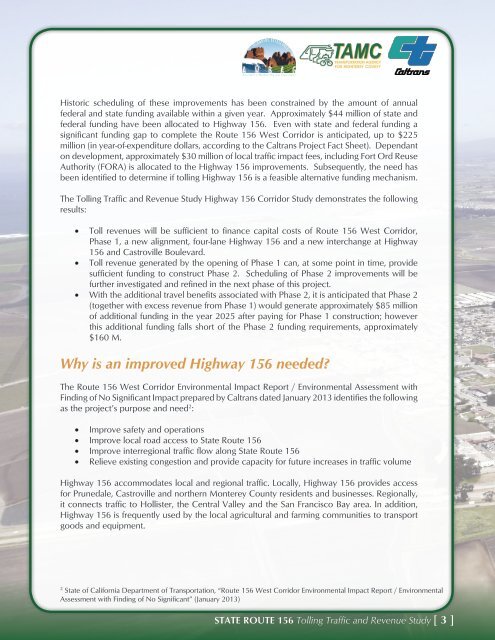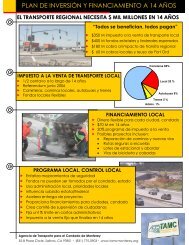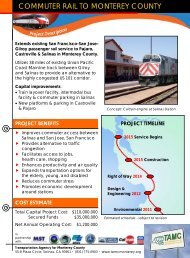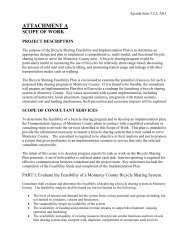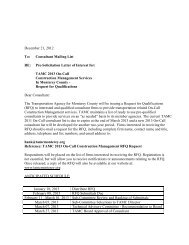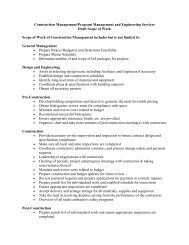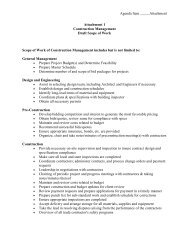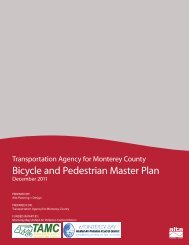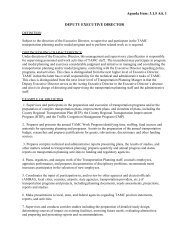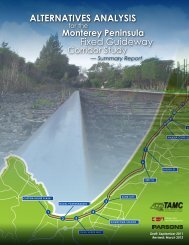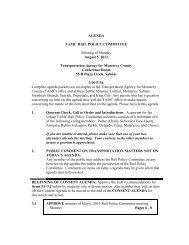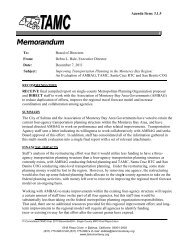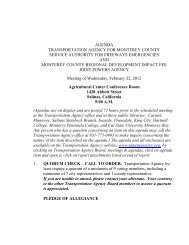156 Toll Road Study and Appendices - Transportation Agency for ...
156 Toll Road Study and Appendices - Transportation Agency for ...
156 Toll Road Study and Appendices - Transportation Agency for ...
- No tags were found...
Create successful ePaper yourself
Turn your PDF publications into a flip-book with our unique Google optimized e-Paper software.
Historic scheduling of these improvements has been constrained by the amount of annualfederal <strong>and</strong> state funding available within a given year. Approximately $44 million of state <strong>and</strong>federal funding have been allocated to Highway <strong>156</strong>. Even with state <strong>and</strong> federal funding asignificant funding gap to complete the Route <strong>156</strong> West Corridor is anticipated, up to $225million (in year-of-expenditure dollars, according to the Caltrans Project Fact Sheet). Dependanton development, approximately $30 million of local traffic impact fees, including Fort Ord ReuseAuthority (FORA) is allocated to the Highway <strong>156</strong> improvements. Subsequently, the need hasbeen identified to determine if tolling Highway <strong>156</strong> is a feasible alternative funding mechanism.The <strong>Toll</strong>ing Traffic <strong>and</strong> Revenue <strong>Study</strong> Highway <strong>156</strong> Corridor <strong>Study</strong> demonstrates the followingresults:• <strong>Toll</strong> revenues will be sufficient to finance capital costs of Route <strong>156</strong> West Corridor,Phase 1, a new alignment, four-lane Highway <strong>156</strong> <strong>and</strong> a new interchange at Highway<strong>156</strong> <strong>and</strong> Castroville Boulevard.• <strong>Toll</strong> revenue generated by the opening of Phase 1 can, at some point in time, providesufficient funding to construct Phase 2. Scheduling of Phase 2 improvements will befurther investigated <strong>and</strong> refined in the next phase of this project.• With the additional travel benefits associated with Phase 2, it is anticipated that Phase 2(together with excess revenue from Phase 1) would generate approximately $85 millionof additional funding in the year 2025 after paying <strong>for</strong> Phase 1 construction; howeverthis additional funding falls short of the Phase 2 funding requirements, approximately$160 M.Why is an improved Highway <strong>156</strong> needed?The Route <strong>156</strong> West Corridor Environmental Impact Report / Environmental Assessment withFinding of No Significant Impact prepared by Caltrans dated January 2013 identifies the followingas the project’s purpose <strong>and</strong> need 2 :• Improve safety <strong>and</strong> operations• Improve local road access to State Route <strong>156</strong>• Improve interregional traffic flow along State Route <strong>156</strong>• Relieve existing congestion <strong>and</strong> provide capacity <strong>for</strong> future increases in traffic volumeHighway <strong>156</strong> accommodates local <strong>and</strong> regional traffic. Locally, Highway <strong>156</strong> provides access<strong>for</strong> Prunedale, Castroville <strong>and</strong> northern Monterey County residents <strong>and</strong> businesses. Regionally,it connects traffic to Hollister, the Central Valley <strong>and</strong> the San Francisco Bay area. In addition,Highway <strong>156</strong> is frequently used by the local agricultural <strong>and</strong> farming communities to transportgoods <strong>and</strong> equipment.2State of Cali<strong>for</strong>nia Department of <strong>Transportation</strong>, “Route <strong>156</strong> West Corridor Environmental Impact Report / EnvironmentalAssessment with Finding of No Significant” (January 2013)STATE ROUTE <strong>156</strong> <strong>Toll</strong>ing Traffic <strong>and</strong> Revenue <strong>Study</strong> [ 3 ]


